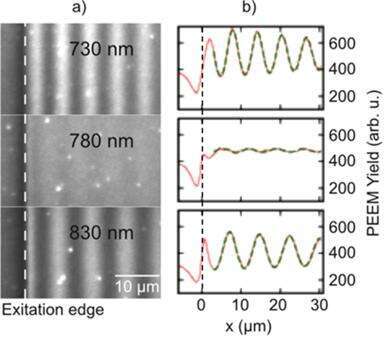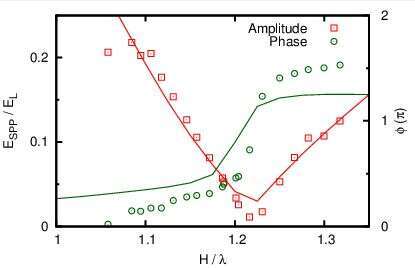
Amplitude and Phase of Surface Plasmon Polaritons Excited at Step Edges
We present a combined theoretical and experimental study on the laser-induced excitation of surface plasmon polaritons (SPPs) at defined step edges representing one of the most basic light-SPP coupling geometries. The calculations are performed within an integral equation approach for the solution of two-dimensional scattering problems [1], whereas in the experimental part we utilized two-photon photoemission electron microscopy (2P-PEEM) [2]. Analysis of the data provides information on the laser-SPP coupling efficiency of the step edges and the phase of the excited SPP.

Fig. 1 a) 2P-PEEM images taken at a step height of 950 nm at illumination with laser pulses of different central wavelengths; the periodic intensity pattern is the experimental signature for SPP excitation; b) 2P-PEEM intensity profiles (red lines) of Fig. 1 a).
As an important parameter determining the coupling efficiency we identify the ratio between step height H and excitation wavelength λ. For specific values of H/λ a substantial suppression of light-SPP coupling is observed (see Fig. 1). At the same time the phase of the SPP undergoes an overall shift by π (see experimental and theoretical data in Fig. 2). Based on the calculations it is possible to assign the changes in coupling efficiency and phase to the interference of incident and reflected laser field in the presence of the step edge.

Fig. 2 Coupling efficiency (red) and SPP phase (green) at the step edge as derived from the analysis of the experimental data (open symbols) and the calculations (solid lines).
References:
[1] De la Cruz, S. et al., Physica Status Solidi (B), 249(6), (2012)
[2] Lemke, C. et al., Applied Physics B 116. (2013)
alwin.klick@physik.uni-kiel.de
Powered by Eventact EMS